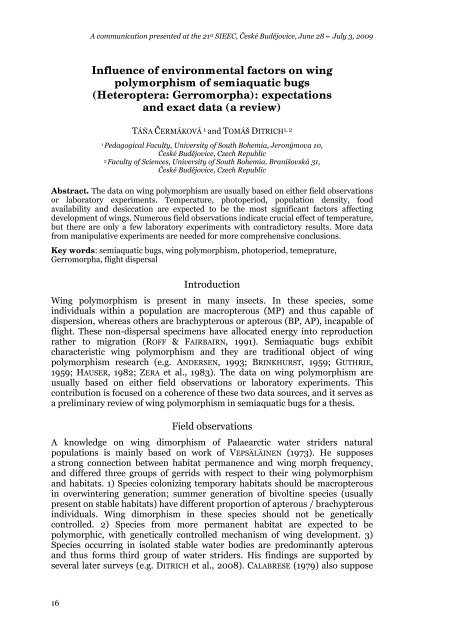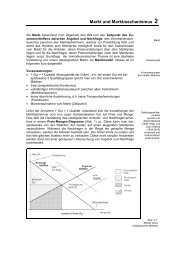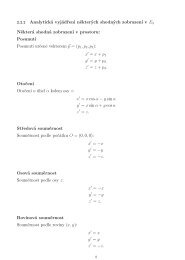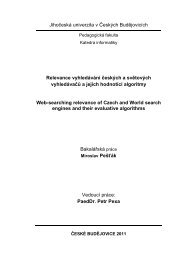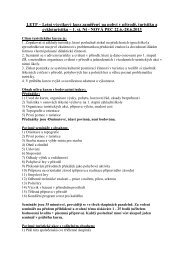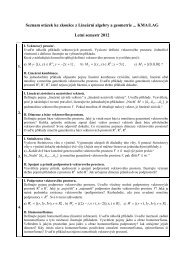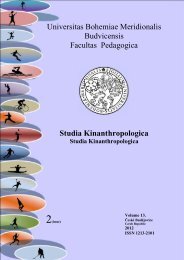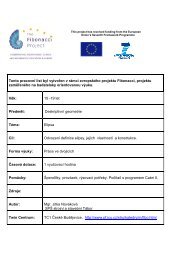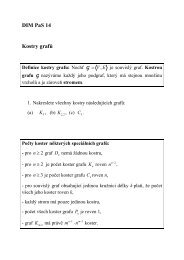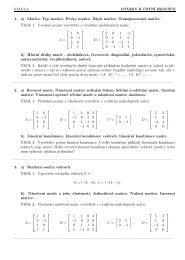Influence of environmental factors on wing polymorphism of ...
Influence of environmental factors on wing polymorphism of ...
Influence of environmental factors on wing polymorphism of ...
Create successful ePaper yourself
Turn your PDF publications into a flip-book with our unique Google optimized e-Paper software.
A communicati<strong>on</strong> presented at the 21 st SIEEC, České Budějovice, June 28 – July 3, 2009<str<strong>on</strong>g>Influence</str<strong>on</strong>g> <str<strong>on</strong>g>of</str<strong>on</strong>g> <str<strong>on</strong>g>envir<strong>on</strong>mental</str<strong>on</strong>g> <str<strong>on</strong>g>factors</str<strong>on</strong>g> <strong>on</strong> <strong>wing</strong><strong>polymorphism</strong> <str<strong>on</strong>g>of</str<strong>on</strong>g> semiaquatic bugs(Heteroptera: Gerromorpha): expectati<strong>on</strong>sand exact data (a review)TÁŇA ČERMÁKOVÁ 1 and TOMÁŠ DITRICH 1, 21 Pedagogical Faculty, University <str<strong>on</strong>g>of</str<strong>on</strong>g> South Bohemia, Jer<strong>on</strong>ýmova 10,České Budějovice, Czech Republic2 Faculty <str<strong>on</strong>g>of</str<strong>on</strong>g> Sciences, University <str<strong>on</strong>g>of</str<strong>on</strong>g> South Bohemia, Branišovská 31,České Budějovice, Czech RepublicAbstract. The data <strong>on</strong> <strong>wing</strong> <strong>polymorphism</strong> are usually based <strong>on</strong> either field observati<strong>on</strong>sor laboratory experiments. Temperature, photoperiod, populati<strong>on</strong> density, foodavailability and desiccati<strong>on</strong> are expected to be the most significant <str<strong>on</strong>g>factors</str<strong>on</strong>g> affectingdevelopment <str<strong>on</strong>g>of</str<strong>on</strong>g> <strong>wing</strong>s. Numerous field observati<strong>on</strong>s indicate crucial effect <str<strong>on</strong>g>of</str<strong>on</strong>g> temperature,but there are <strong>on</strong>ly a few laboratory experiments with c<strong>on</strong>tradictory results. More datafrom manipulative experiments are needed for more comprehensive c<strong>on</strong>clusi<strong>on</strong>s.Key words: semiaquatic bugs, <strong>wing</strong> <strong>polymorphism</strong>, photoperiod, temeprature,Gerromorpha, flight dispersalIntroducti<strong>on</strong>Wing <strong>polymorphism</strong> is present in many insects. In these species, someindividuals within a populati<strong>on</strong> are macropterous (MP) and thus capable <str<strong>on</strong>g>of</str<strong>on</strong>g>dispersi<strong>on</strong>, whereas others are brachypterous or apterous (BP, AP), incapable <str<strong>on</strong>g>of</str<strong>on</strong>g>flight. These n<strong>on</strong>-dispersal specimens have allocated energy into reproducti<strong>on</strong>rather to migrati<strong>on</strong> (ROFF & FAIRBAIRN, 1991). Semiaquatic bugs exhibitcharacteristic <strong>wing</strong> <strong>polymorphism</strong> and they are traditi<strong>on</strong>al object <str<strong>on</strong>g>of</str<strong>on</strong>g> <strong>wing</strong><strong>polymorphism</strong> research (e.g. ANDERSEN, 1993; BRINKHURST, 1959; GUTHRIE,1959; HAUSER, 1982; ZERA et al., 1983). The data <strong>on</strong> <strong>wing</strong> <strong>polymorphism</strong> areusually based <strong>on</strong> either field observati<strong>on</strong>s or laboratory experiments. Thisc<strong>on</strong>tributi<strong>on</strong> is focused <strong>on</strong> a coherence <str<strong>on</strong>g>of</str<strong>on</strong>g> these two data sources, and it serves asa preliminary review <str<strong>on</strong>g>of</str<strong>on</strong>g> <strong>wing</strong> <strong>polymorphism</strong> in semiaquatic bugs for a thesis.Field observati<strong>on</strong>sA knowledge <strong>on</strong> <strong>wing</strong> dimorphism <str<strong>on</strong>g>of</str<strong>on</strong>g> Palaearctic water striders naturalpopulati<strong>on</strong>s is mainly based <strong>on</strong> work <str<strong>on</strong>g>of</str<strong>on</strong>g> VEPSÄLÄINEN (1973). He supposesa str<strong>on</strong>g c<strong>on</strong>necti<strong>on</strong> between habitat permanence and <strong>wing</strong> morph frequency,and differed three groups <str<strong>on</strong>g>of</str<strong>on</strong>g> gerrids with respect to their <strong>wing</strong> <strong>polymorphism</strong>and habitats. 1) Species col<strong>on</strong>izing temporary habitats should be macropterousin overwintering generati<strong>on</strong>; summer generati<strong>on</strong> <str<strong>on</strong>g>of</str<strong>on</strong>g> bivoltine species (usuallypresent <strong>on</strong> stable habitats) have different proporti<strong>on</strong> <str<strong>on</strong>g>of</str<strong>on</strong>g> apterous / brachypterousindividuals. Wing dimorphism in these species should not be geneticallyc<strong>on</strong>trolled. 2) Species from more permanent habitat are expected to bepolymorphic, with genetically c<strong>on</strong>trolled mechanism <str<strong>on</strong>g>of</str<strong>on</strong>g> <strong>wing</strong> development. 3)Species occurring in isolated stable water bodies are predominantly apterousand thus forms third group <str<strong>on</strong>g>of</str<strong>on</strong>g> water striders. His findings are supported byseveral later surveys (e.g. DITRICH et al., 2008). CALABRESE (1979) also suppose16
c<strong>on</strong>necti<strong>on</strong> between <strong>wing</strong> morph and type <str<strong>on</strong>g>of</str<strong>on</strong>g> habitat in Nearctic water striders,with effect <str<strong>on</strong>g>of</str<strong>on</strong>g> temperature, photoperiod and genetic mechanism in some species.In general, both genetic and <str<strong>on</strong>g>envir<strong>on</strong>mental</str<strong>on</strong>g> <str<strong>on</strong>g>factors</str<strong>on</strong>g> during egg and larvaldevelopment are thought to affect <strong>wing</strong> dimorphism in gerrids, as previouslyassumed by (BRINKHURST, 1959). Most important <str<strong>on</strong>g>envir<strong>on</strong>mental</str<strong>on</strong>g> <str<strong>on</strong>g>factors</str<strong>on</strong>g>c<strong>on</strong>sidered are temperature and photoperiod, causing low proporti<strong>on</strong> <str<strong>on</strong>g>of</str<strong>on</strong>g>macropterous morph in summer generati<strong>on</strong>. More l<strong>on</strong>g-<strong>wing</strong>ed specimens thusoccur in overwintering generati<strong>on</strong>. Possibility to leave unfavorable habitat is alsoclear advantage. High proporti<strong>on</strong> <str<strong>on</strong>g>of</str<strong>on</strong>g> macropterous individuals can thus besupposed in inhospitable or unstable habitats. Ephemeral habitat (drying out)should be recognized by increased temperature, populati<strong>on</strong> density and probablyalso by food shortage (see MURAJI et al., 1989).Laboratory experimentsThe genetic c<strong>on</strong>trol and effect <str<strong>on</strong>g>of</str<strong>on</strong>g> five <str<strong>on</strong>g>envir<strong>on</strong>mental</str<strong>on</strong>g> c<strong>on</strong>diti<strong>on</strong>s (photoperiod,temperature, populati<strong>on</strong> density, food availability and drying out <str<strong>on</strong>g>of</str<strong>on</strong>g> the habitat =rearing <strong>on</strong> wet filtrate paper) <strong>on</strong> <strong>wing</strong> <strong>polymorphism</strong> has been tested ingerromorphan bugs. We found results for 15 gerromorphan bugs (eight Gerridae,five Veliidae and two Mesoveliidae). Am<strong>on</strong>g these species, nine were tested forpopulati<strong>on</strong> density (five positive (DITRICH & PAPÁČEK, 2009b; HARADA et al.,1997; MURAJI et al., 1989; MURAJI & NAKASUJI, 1988), three n<strong>on</strong>e (DITRICH &PAPÁČEK, 2009b; HARADA & SPENCE, 2000) and <strong>on</strong>e negative effect (HARADA &SPENCE, 2000) <strong>on</strong> development <str<strong>on</strong>g>of</str<strong>on</strong>g> MP specimens. Effect <str<strong>on</strong>g>of</str<strong>on</strong>g> photoperiod wasproved in six (ANDERSEN, 1982; BLANCKENHORN & FAIRBAIRN, 1995; INOUE &HARADA, 1997; MURAJI et al., 1989; VEPSÄLÄINEn, 1974; ZERA et al., 1983) out <str<strong>on</strong>g>of</str<strong>on</strong>g>eight species tested (zero effect: ANDERSEN, 1982; DITRICH & PAPÁČEK, 2009a),effect <str<strong>on</strong>g>of</str<strong>on</strong>g> temperature in three (HARADA, 1992; MURAJI et al., 1989; PFENNING etal., 2008; VEPSÄLÄINEN, 1974) out <str<strong>on</strong>g>of</str<strong>on</strong>g> six species (zero effect: DITRICH & PAPÁČEK,2009a; SPENCE & ANDERSEN, 1994). Wing development was not affected byhabitat desiccati<strong>on</strong> in both species tested (DITRICH & PAPÁČEK, 2009a; KISHI etal., 2002). Increased food availability increased a proporti<strong>on</strong> <str<strong>on</strong>g>of</str<strong>on</strong>g> macropters inMicrovelia douglasi (MURAJI et al., 1989). Genetic mechanisms were found inthree (AHLROTH et al., 1999; SPENCE, 1989; ZERA et al., 1983) out <str<strong>on</strong>g>of</str<strong>on</strong>g> five speciestested (zero effect: ANDERSEN, 1982; FAIRBAIRN, 1988).C<strong>on</strong>clusi<strong>on</strong>According to field observati<strong>on</strong>s, <strong>wing</strong> <strong>polymorphism</strong> is at least partiallyc<strong>on</strong>trolled by <str<strong>on</strong>g>envir<strong>on</strong>mental</str<strong>on</strong>g> c<strong>on</strong>diti<strong>on</strong>s in most species. The most significant<str<strong>on</strong>g>factors</str<strong>on</strong>g> are photoperiod and temperature (seas<strong>on</strong>al, eventually latitudinal<strong>polymorphism</strong>) and temperature, populati<strong>on</strong> density, food shortage andsubstrate desiccati<strong>on</strong> during larval development (when needed to leaveunfavorable or drying habitat). Temperature thus seems to have crucial effect <strong>on</strong><strong>wing</strong> <strong>polymorphism</strong>. Laboratory experiments have validated the photoperiodeffect in most cases, and the change in <strong>wing</strong> morphs proporti<strong>on</strong>s followed lifehistory <str<strong>on</strong>g>of</str<strong>on</strong>g> particular species. However, the effect <str<strong>on</strong>g>of</str<strong>on</strong>g> temperature was studied infew species <strong>on</strong>ly and the results were not c<strong>on</strong>vincing - the effect <str<strong>on</strong>g>of</str<strong>on</strong>g> temperaturewas found <strong>on</strong>ly in a half <str<strong>on</strong>g>of</str<strong>on</strong>g> species. Some species differed in their resp<strong>on</strong>se toincreased populati<strong>on</strong> density when usually more macropterous individuals17
occurred, but the effect was opposite in <strong>on</strong>e species. Substrate desiccati<strong>on</strong> seemsto have no effect, however <strong>on</strong>ly two species has been tested. In general, thelaboratory experiments data are poor and can neither verify nor falsifyhypotheses based <strong>on</strong> field observati<strong>on</strong>s. Especially different temperaturestreatments are needed for more species, if we want to describe temperatureeffect <strong>on</strong> <strong>wing</strong> <strong>polymorphism</strong> in semiaquatic bugs.ReferencesAHLROTH, P., ALATALO, R.V., HYVARINEN, E., & J. SUHONEN (1999) Geographical variati<strong>on</strong> in<strong>wing</strong> <strong>polymorphism</strong> <str<strong>on</strong>g>of</str<strong>on</strong>g> the waterstrider Aquarius najas (Heteroptera, Gerridae).Journal <str<strong>on</strong>g>of</str<strong>on</strong>g> Evoluti<strong>on</strong>ary Biology, 12: 156-160.ANDERSEN, N.M. (1982) The Semiaquatic Bugs (Hemiptera, Gerromorpha). Phylogeny,adaptati<strong>on</strong>s, biogeography, and classificati<strong>on</strong>. Entom<strong>on</strong>ograph, 3: 1-455.ANDERSEN, N.M. (1993) The Evoluti<strong>on</strong> <str<strong>on</strong>g>of</str<strong>on</strong>g> Wing Polymorphism in Water Striders(Gerridae) - a Phylogenetic Approach. Oikos, 67: 433-443.BLANCKENHORN, W.U. & D.J. FAIRBAIRN (1995) Life-History Adaptati<strong>on</strong> Al<strong>on</strong>g a LatitudinalCline in the Water Strider Aquarius-Remigis (Heteroptera, Gerridae). Journal <str<strong>on</strong>g>of</str<strong>on</strong>g>Evoluti<strong>on</strong>ary Biology, 8: 21-41.BRINKHURST, R.O. (1959) Alary Polymorphism in the Gerroidea (Hemiptera-Heteroptera).Journal <str<strong>on</strong>g>of</str<strong>on</strong>g> Animal Ecology, 28: 211-230.CALABRESE, D.M. (1979) Pterygomorphism in 10 Nearctic Species <str<strong>on</strong>g>of</str<strong>on</strong>g> Gerris. AmericanMidland Naturalist, 101: 61-68.DITRICH, T. & M. PAPÁČEK (2009a) Correlated traits for dispersal pattern: terrestrialmigrati<strong>on</strong> in the water cricket Velia caprai (Heteroptera: Gerromorpha: Veliidae).European Journal <str<strong>on</strong>g>of</str<strong>on</strong>g> Entomology, accepted.DITRICH, T. & M. PAPÁČEK (2009b) Effect <str<strong>on</strong>g>of</str<strong>on</strong>g> populati<strong>on</strong> density <strong>on</strong> the development inMesovelia furcata (Mesoveliidae), Microvelia reticulata and Velia caprai (Veliidae)(Heteroptera: Gerromorpha). Publ. in prep.DITRICH, T., PAPÁČEK, M., & T. BROUM (2008) Spatial distributi<strong>on</strong> <str<strong>on</strong>g>of</str<strong>on</strong>g> semiaquatic bugs(Heteroptera: Gerromorpha) and their <strong>wing</strong> morphs in a small scale <str<strong>on</strong>g>of</str<strong>on</strong>g> the PohořskýPotok stream spring area (Novohradské Hory Mts.). Silva Gabreta 14: 173 - 178.FAIRBAIRN, D.J. (1988) Adaptive Significance <str<strong>on</strong>g>of</str<strong>on</strong>g> Wing Dimorphism in the Absence <str<strong>on</strong>g>of</str<strong>on</strong>g>Dispersal - a Comparative-Study <str<strong>on</strong>g>of</str<strong>on</strong>g> Wing Morphs in the Waterstrider, Gerris-Remigis. Ecological Entomology, 13: 273-281.GUTHRIE, D.M. (1959) Polymorphism in the Surface-Water Bugs (Hemipt-Heteropt,Gerroidea). Journal <str<strong>on</strong>g>of</str<strong>on</strong>g> Animal Ecology, 28: 141-152.HARADA, T. (1992) Experimantal analysis <str<strong>on</strong>g>of</str<strong>on</strong>g> the <str<strong>on</strong>g>envir<strong>on</strong>mental</str<strong>on</strong>g> <str<strong>on</strong>g>factors</str<strong>on</strong>g> that c<strong>on</strong>trol alarydimorphism and reproducti<strong>on</strong> in the water strider Aquarius paludum (Fabricius).PhD. thesis, Osaka City University, Osaka, Japan.HARADA, T. & J.R. SPENCE (2000) Nymphal density and life histories <str<strong>on</strong>g>of</str<strong>on</strong>g> two water striders(Hemiptera : Gerridae). Canadian Entomologist, 132: 353-363.HARADA, T., TABUCHI, R., & J. KOURA (1997) Migratory syndrome in the water striderAquarius paludum (Heteroptera: Gerridae) reared in high versus low nymphaldensities. European Journal <str<strong>on</strong>g>of</str<strong>on</strong>g> Entomology, 94: 445-452.HAUSER, R. (1982) Observati<strong>on</strong>s <strong>on</strong> Wing-Polymorphism and Voltinism <str<strong>on</strong>g>of</str<strong>on</strong>g> the P<strong>on</strong>d-Skater Gerris-Lacustris (Hemiptera, Gerridae). Revue Suisse de Zoologie, 89: 903-917.INOUE, T. & T. HARADA (1997) Sensitive stages in the photoperiodic determinati<strong>on</strong> <str<strong>on</strong>g>of</str<strong>on</strong>g> <strong>wing</strong>forms and reproducti<strong>on</strong> in the water strider, Aquarius paludum (Fabricius).Zoological Science, 14: 21-27.KISHI, M., HARADA, T., & J.R. SPENCE (2002) Adult flight in a water strider exposed tohabitat drydown in the larval stages. Naturwissenschaften, 89: 552-554.18
MURAJI, M., MIURA, T., & F. NAKASUJI (1989) Phenological Studies <strong>on</strong> the WingDimorphism <str<strong>on</strong>g>of</str<strong>on</strong>g> a Semi-Aquatic Bug, Microvelia-Douglasi (Heteroptera, Veliidae).Researches <strong>on</strong> Populati<strong>on</strong> Ecology, 31: 129-138.MURAJI, M. & F. NAKASUJI (1988) Comparative Studies <strong>on</strong> Life-History Traits <str<strong>on</strong>g>of</str<strong>on</strong>g> ThreeWing Dimorphic Water Bugs, Microvelia Spp Westwood (Heteroptera, Veliidae).Researches <strong>on</strong> Populati<strong>on</strong> Ecology, 30: 315-327.PFENNING, B., GERSTNER, S., & H.J. POETHKE (2008) Alternative life histories in the waterstrider Gerris lacustris: time c<strong>on</strong>straint <strong>on</strong> <strong>wing</strong> morph and voltinism. EntomologiaExperimentalis Et Applicata, 129: 235-242.ROFF, D.A. & D.J. FAIRBAIRN (1991) Wing Dimorphisms and the Evoluti<strong>on</strong> <str<strong>on</strong>g>of</str<strong>on</strong>g> MigratoryPolymorphisms am<strong>on</strong>g the Insecta. American Zoologist, 31: 243-251.SPENCE, J.R. (1989) The Habitat Templet and Life-History Strategies <str<strong>on</strong>g>of</str<strong>on</strong>g> P<strong>on</strong>d Skaters(Heteroptera, Gerridae) - Reproductive Potential, Phenology, and Wing Dimorphism.Canadian Journal <str<strong>on</strong>g>of</str<strong>on</strong>g> Zoology-Revue Canadienne De Zoologie, 67: 2432-2447.SPENCE, J.R. & N.M. ANDERSEN (1994) Biology <str<strong>on</strong>g>of</str<strong>on</strong>g> Water Striders - Interacti<strong>on</strong>s betweenSystematics and Ecology. Annual Review <str<strong>on</strong>g>of</str<strong>on</strong>g> Entomology, 39: 101-128.VEPSÄLÄINEN, K. (1973) The distributi<strong>on</strong> and habitats <str<strong>on</strong>g>of</str<strong>on</strong>g> Gerris Fabr. species (Heteroptera,Gerridae) in Finland. Annales Zoologici Fennici, 10: 419-444.VEPSÄLÄINEN, K. (1974) Determinati<strong>on</strong> <str<strong>on</strong>g>of</str<strong>on</strong>g> Wing Length and Diapause in Water-Striders(Gerris Fabr, Heteroptera). Hereditas, 77: 163-176.ZERA, A.J., INNES, D.J., & M.E. SAKS (1983) Genetic and Envir<strong>on</strong>mental Determinants <str<strong>on</strong>g>of</str<strong>on</strong>g>Wing Polymorphism in the Waterstrider Limnoporus-Canaliculatus. Evoluti<strong>on</strong>, 37:513-522.19


